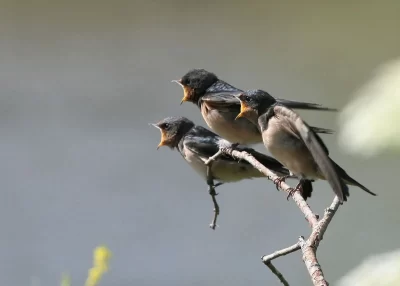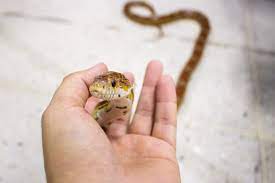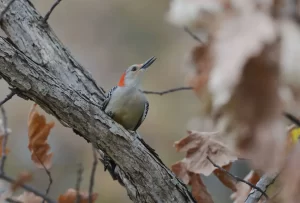The Barn swallow is the most widespread species of swallow in the world. It is a distinctive songbird with blue upperparts and a long, deeply forked tail. There is a line of white spots across the outer end of the upper tail. The female is similar in appearance to the male, but the tail streamers are shorter, the blue of the upperparts and breast band is less glossy, and the underparts paler. The juvenile is browner and has a paler rufous face and whiter underparts. It also lacks the long tail streamers of the adult.
If you wanted to learn more read the full article with Pritish Kumar Halder.

Barn swallow
Distribution
Barn swallows are found in Europe, Asia, Africa, and the Americas. These birds are long-distance migrants and their wintering grounds cover much of the Southern Hemisphere as far south as central Argentina, the Cape Province of South Africa, and northern Australia. The preferred habitat of Barn swallows is open country with low vegetation, such as pasture, meadows, and farmland, preferably with nearby water.
These birds avoid heavily wooded or precipitous areas and densely built-up locations. On their wintering grounds, Barn swallows avoid only dense forests and deserts. They are most common in open, low vegetation habitats, such as savanna and ranch land, and in Venezuela, South Africa, and Trinidad and Tobago the birds are particularly attracted to burnt or harvested sugarcane fields and the waste from the cane.
Habits and Lifestyle
Barn swallows are gregarious birds and in the absence of suitable roost sites, they sometimes roost on wires where they are more exposed to predators. Individual birds tend to return to the same wintering locality each year and congregate from a large area to roost in reed beds.
These roosts can be extremely large and are thought to be a protection from predators. Barn swallows typically feed by day in open areas 7-8 m (23-26 ft) above shallow water or the ground often following animals, humans, or farm machinery to catch disturbed insects; they may also pick prey items from the water surface, walls, and plants. During the breeding, season Barn swallows hunt in pairs, but otherwise form often large flocks. These birds are usually fairly quiet on the wintering grounds.

BARN SWALLOW – habits
At other times they communicate with constant twittering and chattering. The song of the male Barn swallow is a cheerful warble, often ending with ‘su-seer’. Other calls include ‘witt’ or ‘witt-witt’ and a loud ‘splee-plink’ when excited (or trying to chase intruders away from the nest). The alarm calls include a sharp ‘siflitt’ for predators like cats and a ‘flitt-flitt’ for birds of prey like the hobby.
Diet and Nutrition
Barn swallows are carnivores (insectivores). They feed mainly on large flies but also eat bugs, bees, wasps, butterflies, moths, and flying ants.
Mating Habits
Barn swallows are monogamous and pairs stay together to breed for life; however, extra-pair copulation is also common (polygynous behavior). The males return to the breeding grounds before the females and select a nest site, which is then advertised to females with a circling flight and song. The breeding season of these birds varies with location.

BARN SWALLOW – mating habits
Both sexes defend the nest, but the male is particularly aggressive and territorial. Males guard females actively to avoid being cuckolded and may use deceptive alarm calls to prevent any attempts toward their mates. Barn swallows typically nest inside accessible buildings such as barns and stables, or under bridges and wharves. The neat cup-shaped nest is placed on a beam or against a suitable vertical projection.
It is constructed by both sexes, with mud pellets collected in their beaks and lined with grasses, feathers, algae, or other soft materials. The female lays 2 to 7 reddish-spotted white eggs and incubates them for 14-19 days. Altricial (helpless) chicks fledge 18-23 days after hatching but stay with, and are fed by, the parents for about a week after leaving the nest. Young swallows usually start to breed in the first breeding season after they have born.
Population
Population threats
Barn swallows are widespread and abundant throughout their range although there may be local population declines due to specific threats. Among these are climate change and agricultural intensification, which reduces the availability of insect food and barn nesting sites. Climate change may affect Barn swallows in the way that drought causes weight loss and slow feather regrowth, and the expansion of the Sahara will make it a more formidable obstacle for migrating European birds. Hot dry summers will reduce the availability of insect food for chicks.

Barn swallow – babies
Conversely, warmer springs may lengthen the breeding season and result in more chicks, and the opportunity to use nest sites outside buildings in the north of the range might also lead to more offspring.
Population number
According to the IUCN Red List, the total Barn swallow population size is 290,000,000-487,000,000 mature individuals. The European population of this species consists of 29,000,000-48,700,000 million pairs, which equates to 58,000,000-97,400,000 million mature individuals.
The national population estimates include 10,000-1 million breeding pairs and more than 1,000 individuals on migration in China; 10,000-100,000 breeding pairs, more than 10,000 individuals on migration and less than 50 wintering individuals in Taiwan; 10,000-1 million breeding pairs and more than 1,000 individuals on migration in Korea; 10,000-1 million breeding pairs, more than 1,000 individuals on migration and 50-1,000 wintering individuals in Japan and 10,000-100,000 breeding pairs and 1,000-10,000 individuals on migration in Russia. Overall, currently, this species is classified as Least Concern (LC) on the IUCN Red List but its numbers today are decreasing.
Fun Facts for Kids
- The Barn swallow is the national bird of Austria and Estonia.
- Barn swallows are such social birds that in Nigeria, one of their roosts contained up to 1.5 million birds!
- Barn swallows are not particularly fast fliers. They fly with a speed of about 11 meters per second (25 mph) and may reach up to 20 meters per second (45 mph); their wing beat rate is approximately 5, up to 7-9 times each second.
- Barn swallows drink by skimming low over lakes or rivers and scoop up water with their open mouth. These birds also bathe in a similar fashion; they dip into the water for an instant while in flight.
- Barn swallows may produce two broods in one breeding season and occasionally, the young from the first brood will assist their parents in feeding the chicks from the second brood.

Young BARN SWALLOW
- Barn swallows migrate during the day and can feed on the wing while they travel low over ground or water.
- Barn swallows are attractive birds that feed on flying insects and have therefore been tolerated by humans when they share their buildings for nesting. As one of the earlier migrants, these birds are also an early sign of summer’s approach.
- Barn swallows are one of the most depicted birds on postage stamps around the world.
Reference
https://animalia.bio/barn-swallow?environment=331










